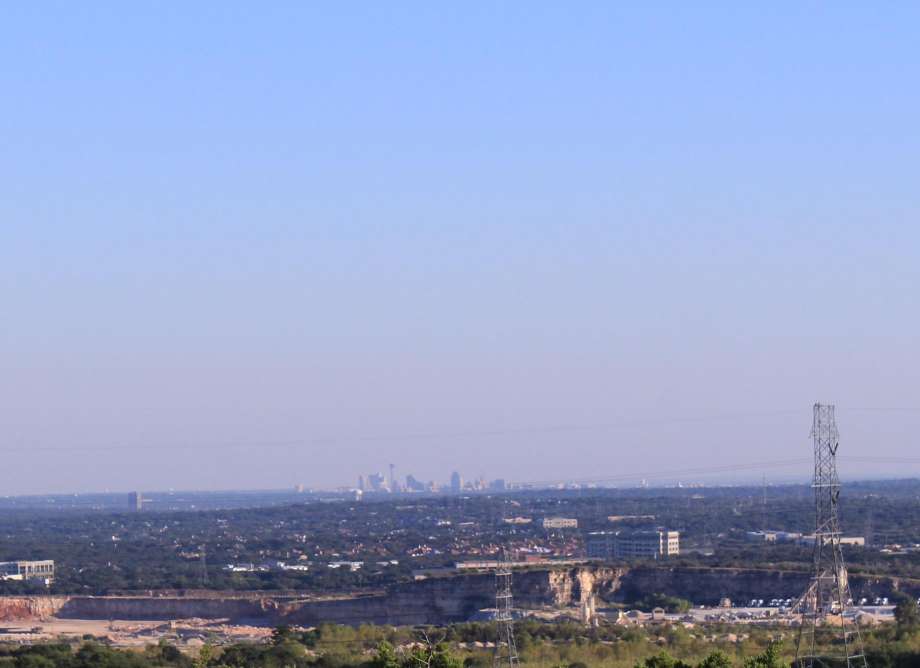Editor's Note: This op-ed was originally published in the San Antonio Express-News on Oct. 7, 2018.
By Adelita G. Cantu

The downtown San Antonio skyline looks hazy from Eisenhower Park on Oct. 2, 2016, the day of a late-season spike in ozone levels. The EPA has said San Antonio is not in attainment on ozone.
So far this year, at least 13 days were considered unsafe for breathing outside. President Donald Trump’s EPA notified San Antonio — with good reason — that it needs to clean up its air by lowering ozone, or smog, levels, yet the EPA has also proposed numerous rollbacks making it easier for industries to pollute and harder for San Antonio to clean its air.
Ground-level ozone forms when nitrogen oxide from cars and trucks, cement kilns, coal plants, and oil and gas activities combine with volatile organic compounds (benzene and butadiene from gas stations, cars, oil and gas activities, paint fumes and dry cleaning chemicals) in the sunlight.
Effects of ground-level ozone are worst on hot summer days. High levels are hazardous and irritating to the lungs and particularly harmful to the young, elderly, those who work outside, and those with asthma or other respiratory issues; they can even lead to increased heart attacks and premature death.
Bexar County has routinely violated safe levels of ozone, and the EPA finally did the right thing and declared the county in “nonattainment” with the ozone standard.
Bexar County now needs to put a plan in place to address it.
Yet while Trump’s EPA is telling Bexar County to clean up its mess, it is proposing rules that would increase the very same pollutants that contribute to dirty skies and ozone formation.
In August, the EPA announced its plan to freeze Obama-era fuel efficiency standards for new cars and trucks. The proposed rollback would freeze required improvements on gas mileage and emissions for six years, and will result in increased ozone pollution and health costs in Bexar County.
Then, the EPA announced its Clean Power Plan replacement, the Affordable Clean Energy Rule. The CPP was designed to require utilities to put themselves on a cleaner path. It would have lowered carbon dioxide levels by 32 percent over 12 years, along with other pollutants like sulfur dioxide and nitrogen oxide. In contrast, the new rule — using the EPA’s own calculations — would lead to 1,400 additional premature deaths and 48,000 new cases of asthma each year nationwide.
If that weren’t enough, the EPA announced a regional haze plan that is supposed to cut sulfur pollution from impacting national parks but instead could keep old Texas coal plants polluting.
Haze is the grungy air caused when coal pollution travels long distances and combines with other air pollution, harming views in places such as Big Bend National Park and the Guadalupe Mountains.
The Clean Air Act requires states, or the EPA, to put together a haze plan. The previous proposed rule for Texas would have significantly reduced sulfur pollution from our oldest, dirtiest coal plants, but the Trump administration ignored these requirements and proposed a plan that could actually increase pollution. The plan would potentially create a market that would allow coal plants slated for retirement, such as CPS Energy’s Deely coal plant, to sell “sulfur pollution credits” to other outdated Texas coal plants, allowing those dirty plants to pollute even more.
Finally, the EPA recently announced that the rule to control methane pollution from new oil and gas drilling activities would be replaced by a rule that would loosen the already modest requirements to control pollution from the oil and gas operations.
The Alamo Area Council of Governments conducted several studies showing that increased oil and gas activity nearby increases the likelihood of ozone formation within Bexar County, especially if producers don’t check for leaks.
So, while Trump’s EPA is finally ordering San Antonio to clean the air we breathe, the cruel — and dangerous — irony is the onslaught of environmental protection rollbacks intended to benefit the fossil fuel industry at the expense of our health and environment.
Fortunately, none of the four proposed rules are final, and we must tell Trump’s EPA and our city leaders that these proposals make it very difficult to protect public health and meet clean air standards.
Adelita G. Cantu, Ph.D., RN, is with the Alliance of Nurses for Healthy Environments.